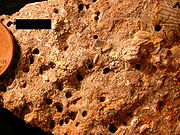
Carbonate hardgrounds
Encyclopedia

Limestone
Limestone is a sedimentary rock composed largely of the minerals calcite and aragonite, which are different crystal forms of calcium carbonate . Many limestones are composed from skeletal fragments of marine organisms such as coral or foraminifera....
sequences and distinguished from later-lithified sediments by evidence of exposure to normal marine waters. This evidence can consist of encrusting marine organisms (especially bryozoans, oysters, barnacles, cornulitids, hederelloids and crinoids), borings of organisms produced through bioerosion
Bioerosion
Bioerosion describes the erosion of hard ocean substrates – and less often terrestrial substrates – by living organisms. Marine bioerosion can be caused by mollusks, polychaete worms, phoronids, sponges, crustaceans, echinoids, and fish; it can occur on coastlines, on coral reefs, and...
, early marine calcite cements, or extensive surfaces mineralized by iron oxides or calcium phosphates (Palmer, 1982; Bodenbender et al., 1989). Modern hardgrounds are usually detected by sounding in shallow water or through remote sensing techniques like side-scan radar.

Cambrian
The Cambrian is the first geological period of the Paleozoic Era, lasting from Mya ; it is succeeded by the Ordovician. Its subdivisions, and indeed its base, are somewhat in flux. The period was established by Adam Sedgwick, who named it after Cambria, the Latin name for Wales, where Britain's...
Period to today (Taylor and Wilson, 2003).


Calcite sea
A calcite sea is one in which low-magnesium calcite is the primary inorganic marine calcium carbonate precipitate. An aragonite sea is the alternate seawater chemistry in which aragonite and high-magnesium calcite are the primary inorganic carbonate precipitates...
intervals in Earth history, which were times of rapid precipitation of low-magnesium calcite
Calcite
Calcite is a carbonate mineral and the most stable polymorph of calcium carbonate . The other polymorphs are the minerals aragonite and vaterite. Aragonite will change to calcite at 380-470°C, and vaterite is even less stable.-Properties:...
and the dissolution of skeletal aragonite
Aragonite
Aragonite is a carbonate mineral, one of the two common, naturally occurring, crystal forms of calcium carbonate, CaCO3...
(Palmer and Wilson, 2004). The Ordovician
Ordovician
The Ordovician is a geologic period and system, the second of six of the Paleozoic Era, and covers the time between 488.3±1.7 to 443.7±1.5 million years ago . It follows the Cambrian Period and is followed by the Silurian Period...
-Silurian
Silurian
The Silurian is a geologic period and system that extends from the end of the Ordovician Period, about 443.7 ± 1.5 Mya , to the beginning of the Devonian Period, about 416.0 ± 2.8 Mya . As with other geologic periods, the rock beds that define the period's start and end are well identified, but the...
and the Jurassic
Jurassic
The Jurassic is a geologic period and system that extends from about Mya to Mya, that is, from the end of the Triassic to the beginning of the Cretaceous. The Jurassic constitutes the middle period of the Mesozoic era, also known as the age of reptiles. The start of the period is marked by...
-Cretaceous
Cretaceous
The Cretaceous , derived from the Latin "creta" , usually abbreviated K for its German translation Kreide , is a geologic period and system from circa to million years ago. In the geologic timescale, the Cretaceous follows the Jurassic period and is followed by the Paleogene period of the...
Systems have the most hardgrounds (sometimes hundreds in a single section) and the Permian
Permian
The PermianThe term "Permian" was introduced into geology in 1841 by Sir Sir R. I. Murchison, president of the Geological Society of London, who identified typical strata in extensive Russian explorations undertaken with Edouard de Verneuil; Murchison asserted in 1841 that he named his "Permian...
-Triassic
Triassic
The Triassic is a geologic period and system that extends from about 250 to 200 Mya . As the first period of the Mesozoic Era, the Triassic follows the Permian and is followed by the Jurassic. Both the start and end of the Triassic are marked by major extinction events...
Systems have the least (usually none). This cyclicity in hardground formation is reflected in the evolution of hardground-dwelling communities. There are distinct differences between the Paleozoic and Mesozoic hardground communities: the former are dominated by thick calcitic bryozoans and echinoderms, the latter by oysters and deep bivalve (Gastrochaenolites
Gastrochaenolites
Gastrochaenolites is a trace fossil formed as a clavate boring in a hard substrate such as a shell, rock or carbonate hardground. The aperture of the boring is narrower than the main chamber and may be circular, oval, or dumb-bell shaped...
) and sponge (Entobia
Entobia
Entobia is a trace fossil in a hard substrate formed by clionaid sponges as a branching network of galleries, often with regular enlargements termed chambers...
) borings (Taylor and Wilson, 2003).
Stratigraphers and sedimentologists often use hardgrounds as marker horizon
Marker horizon
Marker horizons or chronohorizons or marker beds are stratigraphic units of the same age and of such distinctive composition and appearance, that, despite their presence in separate geographic locations, there is no doubt about their being of equivalent age and of common origin...
s and as indicators of sedimentary hiatuses and flooding events (Fürsich et al., 1981, 1992; Pope and Read, 1997). Hardgrounds and their faunas can also represent very specific depositional environments
Sedimentary depositional environment
In geology, sedimentary depositional environment describes the combination of physical, chemical and biological processes associated with the deposition of a particular type of sediment and, therefore, the rock types that will be formed after lithification, if the sediment is preserved in the rock...
such as tidal channels (Wilson et al., 2005) and shallow marine carbonate ramps (Palmer and Palmer, 1977; Malpas et al., 2004)

